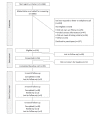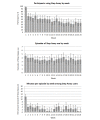Usability and Acceptability of a Mobile App for the Self-Management of Alcohol Misuse Among Veterans (Step Away): Pilot Cohort Study
- PMID: 33830064
- PMCID: PMC8063094
- DOI: 10.2196/25927
Usability and Acceptability of a Mobile App for the Self-Management of Alcohol Misuse Among Veterans (Step Away): Pilot Cohort Study
Abstract
Background: Alcohol misuse is common among Operation Enduring Freedom and Operation Iraqi Freedom veterans, yet barriers limit treatment participation. Mobile apps hold promise as means to deliver alcohol interventions to veterans who prefer to remain anonymous, have little time for conventional treatments, or live too far away to attend treatment in person.
Objective: This pilot study evaluated the usability and acceptability of Step Away, a mobile app designed to reduce alcohol-related risks, and explored pre-post changes on alcohol use, psychological distress, and quality of life.
Methods: This single-arm pilot study recruited Operation Enduring Freedom and Operation Iraqi Freedom veterans aged 18 to 55 years who exceeded National Institute on Alcohol Abuse and Alcoholism drinking guidelines and owned an iPhone. Enrolled veterans (N=55) completed baseline and 1-, 3-, and 6-month assessments. The System Usability Scale (scaled 1-100, ≥70 indicating acceptable usability) assessed the effectiveness, efficiency, and satisfaction dimensions of usability, while a single item (scaled 1-9) measured the attractiveness of 10 screenshots. Learnability was assessed by app use during week 1. App engagement (proportion of participants using Step Away, episodes of use, and minutes per episode per week) over 6 months measured acceptability. Secondary outcomes included pre-post change on heavy drinking days (men: ≥5 drinks per day; women: ≥4 drinks per day) and Short Inventory of Problems-Revised, Kessler-10, and brief World Health Organization Quality of Life Questionnaire scores.
Results: Among the 55 veterans enrolled in the study, the mean age was 37.4 (SD 7.6), 16% (9/55) were women, 82% (45/55) were White, and 82% (45/55) had an alcohol use disorder. Step Away was used by 96% (53/55) of participants in week 1, 55% (30/55) in week 4, and 36% (20/55) in week 24. Step Away use averaged 55.1 minutes (SD 57.6) in week 1 and <15 minutes per week in weeks 2 through 24. Mean System Usability Scale scores were 69.3 (SD 19.7) and 71.9 (SD 15.8) at 1 and 3 months, respectively. Median attractiveness scores ranged from 5 to 8, with lower ratings for text-laden screens. Heavy drinking days decreased from 29.4% (95% CI 23.4%-35.4%) at baseline to 16.2% (95% CI 9.9%-22.4%) at 6 months (P<.001). Likewise, over 6 months, Short Inventory of Problems-Revised scores decreased from 6.3 (95% CI 5.1-7.5) to 3.6 (95% CI 2.4-4.9) (P<.001) and Kessler-10 scores decreased from 18.8 (95% CI 17.4-20.1) to 17.3 (95% CI 15.8-18.7) (P=.046). Changes were not detected on quality of life scores.
Conclusions: Operation Enduring Freedom and Operation Iraqi Freedom veterans found the usability of Step Away to be acceptable and engaged in the app over the 6-month study. Reductions were seen in heavy drinking days, alcohol-related problems, and Kessler-10 scores. A larger randomized trial is warranted to confirm our findings.
Keywords: access; alcohol misuse; mobile apps; smartphone; veterans.
©Carol A Malte, Patrick L Dulin, John S Baer, John C Fortney, Anissa N Danner, Aline M K Lott, Eric J Hawkins. Originally published in JMIR mHealth and uHealth (http://mhealth.jmir.org), 08.04.2021.
Conflict of interest statement
Conflicts of Interest: PLD has an ownership interest in the company that owns Step Away.
Figures



Similar articles
-
U.S. veterans' experiences and factors associated with use of a smartphone application to self-manage unhealthy alcohol use.Psychol Serv. 2023 Nov;20(4):908-917. doi: 10.1037/ser0000716. Epub 2022 Oct 13. Psychol Serv. 2023. PMID: 36227298 Free PMC article.
-
A Brief Cognitive Behavioral Therapy-Based Digital Intervention for Reducing Hazardous Alcohol Use in South Korea: Development and Prospective Pilot Study.JMIR Form Res. 2025 Mar 19;9:e64459. doi: 10.2196/64459. JMIR Form Res. 2025. PMID: 40106827 Free PMC article.
-
From "Step Away" to "Stand Down": Tailoring a Smartphone App for Self-Management of Hazardous Drinking for Veterans.JMIR Mhealth Uhealth. 2020 Feb 13;8(2):e16062. doi: 10.2196/16062. JMIR Mhealth Uhealth. 2020. PMID: 32053118 Free PMC article.
-
Mobile Apps to Reduce Tobacco, Alcohol, and Illicit Drug Use: Systematic Review of the First Decade.J Med Internet Res. 2020 Nov 24;22(11):e17156. doi: 10.2196/17156. J Med Internet Res. 2020. PMID: 33231555 Free PMC article.
-
A Patient-Oriented App (ThessHF) to Improve Self-Care Quality in Heart Failure: From Evidence-Based Design to Pilot Study.JMIR Mhealth Uhealth. 2021 Apr 13;9(4):e24271. doi: 10.2196/24271. JMIR Mhealth Uhealth. 2021. PMID: 33847599 Free PMC article.
Cited by
-
Effectiveness of the WeChat-based mini-program ("Sober Time ACT") on individuals with hazardous drinking in China: a randomized controlled trial.BMC Med. 2025 Jul 1;23(1):385. doi: 10.1186/s12916-025-04217-5. BMC Med. 2025. PMID: 40598563 Free PMC article. Clinical Trial.
-
Engagement with mHealth Alcohol Interventions: User Perspectives on an App or Chatbot-Delivered Program to Reduce Drinking.Healthcare (Basel). 2024 Jan 2;12(1):101. doi: 10.3390/healthcare12010101. Healthcare (Basel). 2024. PMID: 38201007 Free PMC article.
-
Contrasting a Mobile App With a Conversational Chatbot for Reducing Alcohol Consumption: Randomized Controlled Pilot Trial.JMIR Form Res. 2022 May 16;6(5):e33037. doi: 10.2196/33037. JMIR Form Res. 2022. PMID: 35576569 Free PMC article.
-
User Engagement With mHealth Interventions to Promote Treatment Adherence and Self-Management in People With Chronic Health Conditions: Systematic Review.J Med Internet Res. 2024 Sep 24;26:e50508. doi: 10.2196/50508. J Med Internet Res. 2024. PMID: 39316431 Free PMC article.
-
Pilot Trial of a Smartphone-Based Intervention to Reduce Alcohol Consumption among Veterans with HIV.Mil Behav Health. 2023;11(1-2):66-77. doi: 10.1080/21635781.2023.2221465. Epub 2023 Jun 14. Mil Behav Health. 2023. PMID: 38405355 Free PMC article.
References
-
- Rehm J, Gmel G, Sempos CT, Trevisan M. Alcohol-related morbidity and mortality. Alcohol Res Health. 2003;27(1):39–51. http://pubs.niaaa.nih.gov/publications/arh27-1/39-51.pdf - PMC - PubMed
Publication types
MeSH terms
Grants and funding
LinkOut - more resources
Full Text Sources
Other Literature Sources
Medical

